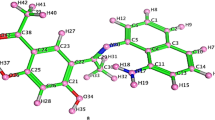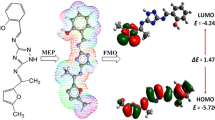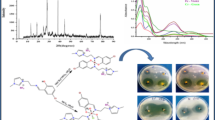Abstract
A series of transition metal complexes of Co(II), Ni(II), Cu(II), and Zn(II) metal ions with various uninegative bidentate Schiff base ligands derived from condensation of piperonylamine and 2-hydroxy-1-naphthaldehyde/substituted salicylaldehyde derivatives were synthesized and were well characterized by different spectroscopic techniques (FT-IR, UV–Vis, NMR, fluorescence, mass, and ESR), molar conductance measurements, elemental analysis and by various physical studies like thermal (TGA, DTG, and DTA) and magnetic susceptibility measurements. The characterization data revealed that Schiff bases’ coordinates via azomethine nitrogen and deprotonated phenolic oxygen (NO) with metal centres in 2:1 molar ratio with octahedral geometrical arrangement for Co(II), Ni(II), and Zn(II) complexes and square planar geometry for Cu(II) complexes. The synthesized compounds were evaluated for their in vitro antimicrobial activities against two Gram-positive bacteria (Staphylococcus aureus and Streptococcus gordonii); two Gram-negative bacteria (Escherichia coli and Pseudomonas aeruginosa); and two fungal strains (Aspergillus niger and Candida albicans). Comparative biological study indicated that metal complexes were more noxious as compared to free ligands and Zn(II) complexes were found to be most potent antimicrobial agents among all the synthesized complexes. The complexes 23–30 showed excellent activity against tested microorganisms. Quantitative structure–activity relationship study of compounds was made for antimicrobial assessment which exposed that metal complexes with high molecular weight were more potent against E coli.
Graphical Abstract











Similar content being viewed by others
References
Abdel-Rahman LH, Abu-Dief AM, El-Khatib RM, Abdel-Fatah SM (2016) Some new nano-sized Fe(II), Cd(II) and Zn(II) Schiff base complexes as precursor for metal oxides: sonochemical synthesis, characterization, DNA interaction, in vitro antimicrobial and anticancer activities. Bioorg Chem 69:140–152. https://doi.org/10.1016/j.bioorg.2016.10.009
Abd-Elzaher MM, Moustafa SA, Labib AA, Mousa HA, Ali MM, Mahmoud AE (2012a) Synthesis, characterization and anticancer studies of ferrocenyl complexes containing thiazole moiety. Appl Organomet Chem 26:230–236. https://doi.org/10.1002/aoc.2844
Abd-Elzaher MM, Moustafa SA, Mousa HA, Labib AA (2012b) Synthesis and biological activity of a ferrocenyl ligand derived from thiophenol and its coordination with some transition metals. Monatsh Chem 143(6):909–913. https://doi.org/10.1007/s00706-011-0685-1
Alaghaz AMA, Bayoumi HA, Ammar YA, Aldhlmani SA (2013) Synthesis, characterization, and antipathogenic studies of some transition metal complexes with N, O-chelating Schiff’s base ligand incorporating azo and sulfonamide moieties. J Mol Struct 13:383–399. https://doi.org/10.1016/j.molstruc.2012.11.030
Andersen O (1999) Principles and recent developments in chelation treatment of metal intoxication. Chem Rev 99(9):2683–2710. https://doi.org/10.1021/cr980453a
Anitha C, Sheela CD, Tharmaraj P, Sumathi S (2012) Spectroscopic studies and biological evaluation of some transition metal complexes of azo Schiff-base ligand derived from (1-phenyl-2,3-dimethyl-4-aminopyrazol-5-one) and 5-((4-chlorophenyl)diazenyl)-2-hydroxybenzaldehyde. Spectrochim Acta A 96:493–500. https://doi.org/10.1016/j.saa.2012.05.053
Anupama B, Sunita M, Leela DS, Ushaiah B, Kumari CG (2014) Synthesis, spectral characterization, DNA binding studies and antimicrobial activity of Co(II), Ni(II), Zn(II), Fe(II) and VO(IV) complexes with 4-aminoantipyrine Schiff base of O-vanillin. J Fluoresc 24(4):1067–1076. https://doi.org/10.1007/s10895-014-1386-z
Basak S, Sen S, Banerjee S, Mitra S, Rosair G, Rodriguez MT (2007) Three new pseudohalide bridged dinuclear Zn(II) Schiff base complexes: synthesis, crystal structures and fluorescence studies. Polyhedron 26:5104–5112. https://doi.org/10.1016/j.poly.2007.07.025
Bew MJ, Hathaway BJ, Fereday RJ (1972) Electronic properties and stereochemistry of the copper(II) ion. Part VII. Mono(diethylenetriamine)copper(II) complexes. Dalton Trans 12:1229–1237. https://doi.org/10.1039/DT9720001229
Chang HQ, Jia L, Xu J, Zhu TF, Xu ZQ, Chen RH (2016) Synthesis, crystal structures, anticancer activities of three reduce Schiff base ligand based transition metal complexes. J Mol Struct 1106:366–372. https://doi.org/10.1016/j.molstruc.2015.11.001
ChemBio3D Ultra version 11.0.1, © 1986–2007 Cambridge Soft
Consonni V, Ballabio D, Todeschini R (2009) Comments on the definition of the Q2 parameter for QSAR validation. J Chem Inf Model 49(7):1669–1678. https://doi.org/10.1021/ci900115y
Devi J, Batra N (2015) Synthesis, characterization and antimicrobial activities of mixed ligand transition metal complexes with isatin monohydrazone Schiff base ligands and heterocyclic nitrogen base. Spectrochim Acta A 135:710–719. https://doi.org/10.1016/j.saa.2014.07.041
Devi J, Batra N, Malhotra R (2012) Ligational behavior of Schiff bases towards transition metal ion and metallation effect on their antibacterial activity. Spectrochim Acta A 97:397–405. https://doi.org/10.1016/j.saa.2012.06.026
Devi J, Devi S, Kumar A (2016a) Synthesis, antibacterial evaluation and QSAR analysis of Schiff base complexes derived from [2,2′-(ethylenedioxy)bis(ethylamine)] and aromatic aldehydes. Med Chem Comm 7:932–947. https://doi.org/10.1039/C5MD00554J
Devi J, Devi S, Kumar A (2016b) Synthesis, spectral, and in vitro antimicrobial studies of organosilicon(IV) complexes with Schiff bases derived from dehydroacetic acid. Monatsh Chem 147:2195–2207. https://doi.org/10.1007/s00706-016-1720-z
Dhayabaran VV, Prakash TD, Renganathan R, Friehs E, Bahnemann DW (2017) Novel Bioactive Co(II), Cu(II), Ni(II) and Zn(II) Complexes with Schiff base ligand derived from histidine and 1,3-Indandione: synthesis, structural elucidation, biological investigation and Docking analysis. J Fluoresc 27(1):135–150. https://doi.org/10.1007/s10895-016-1941-x
Diab MA, El-Sonbati AZ, Mohamed RH (2010) Polymer complexes LIII. Supramolecular coordination modes and structural of novel sulpha drug complexes. Spectrochim Acta A 77:795–801. https://doi.org/10.1016/j.saa.2010.08.006
Efthimiadou EK, Katsaros N, Karaliota A, Psomas G (2007) Synthesis, characterization, antibacterial activity, and interaction with DNA of the vanadyl-enrofloxacin complex. Bioorg Med Chem Lett 17(5):1238–1242. https://doi.org/10.1016/j.bmcl.2006.12.032
El-Sonbati AZ, Diab MA, El-Bindary AA, Nozha SG (2011) Structural and characterization of novel copper(II) azodye complexes. Spectrochim Acta A 83(1):490–498. https://doi.org/10.1016/j.saa.2011.08.070
Gramatica P (2007) Principles of QSAR models validation: internal and external. QSAR Comb Sci 26(5):694–701. https://doi.org/10.1002/qsar.200610151
Gramatica P, Chirico N, Papa E, Cassani S, Kovarich S (2013) QSARINS: a new software for the development, analysis, and validation of QSAR MLR models. J Comput Chem 34(24):2121–2132. https://doi.org/10.1002/jcc.23361
Gramatica P, Cassani S, Chirico N (2014) QSARINS-Chem: Insuberia datasets and new QSAR/QSPR models for environmental pollutants in QSARINS. J Comput Chem 35(13):1036–1044. https://doi.org/10.1002/jcc.23576
Ikechukwu PE, Peter AA (2015) Synthesis, characterization, antioxidant, and antibacterial studies of some metal (II) complexes of tetradentate Schiff base ligand: (4E)-4-[(2-{(E)-[1-(2,4-dihydroxyphenyl)ethylidene]amino}ethyl)imino]pentan-2-one. Bioinorg Chem Appl 2015:1–9. https://doi.org/10.1155/2015/890734
Joseyphus RS, Dhanaraj CJ, Nair MS (2006) Synthesis and characterization of some Schiff base transition metal complexes derived from vanillin and L (+) alanine. Trans Met Chem 31:699–702. https://doi.org/10.1007/s11243-006-0048-7
Khan SA, Nami AA, Bhat SA, Kareem A, Nishat N (2017) Synthesis, characterization and antimicrobial study of polymeric transition metal complexes of Mn(II), Co(II), Ni(II), Cu(II) and Zn(II). Microb Pathog 110:414–425. https://doi.org/10.1016/j.micpath.2017.07.008
Khatkar P, Asija S, Singh N (2017) Synthesis, spectral studies and in vitro antimicrobial activity of some new di-/tri-organotin(IV) complexes of Schiff base derived from 2-benzoylpyridine. J Serb Chem Soc 82:13–23. https://doi.org/10.2298/JSC160429089K
Kozłowski H, Kowalik JT, Jeżowska BM (2005) Chemical and biological aspects of Cu2+ interactions with peptides and aminoglycosides. Coord Chem Rev 249:2323–2334. https://doi.org/10.1016/j.ccr.2005.04.027
Kumar A, Chauhan S (2017) QSAR modelling of natural lipase inhibitors using hybrid optimal descriptors. SAR QSAR Environ Res 28(3):179–197. https://doi.org/10.1080/1062936X.2017.1293729
Kursunlu AN, Guler E, Dumrul H, Kocyigit O, Gubbuk IH (2009) Chemical modification of silica gel with synthesized new Schiff base derivatives and sorption studies of cobalt (II) and nickel (II). Appl Surf Sci 255:8798–8803. https://doi.org/10.1016/j.apsusc.2009.06.055
Lakshmipraba J, Arunachalam S, Soloman RV, Venuvanalingam Riyasdeen A, Dhivya R, Akbarsha MA (2015) Surfactant-copper(II) Schiff base complexes: synthesis, structural investigation, DNA interaction, docking studies, and cytotoxic activity. J Biomol Struct Dyn 33(4):877–891. https://doi.org/10.1080/07391102.2014.918523
Lee SK, Tan KW, Ng SW, Ooi KK, Ang KP, Abdah MA (2014) Zinc(II) complex with cationic Schiff base ligand: synthesis, characterization and biological studies. Spectrochim Acta A 121:101–108. https://doi.org/10.1016/j.saa.2013.10.084
Majumder A, Rosair GM, Mallick A, Chattopadhyay AN, Mitra S (2006) Synthesis, structures and fluorescence of nickel, zinc and cadmium complexes with the N, N, O-tridentate Schiff base N-2-pyridylmethylidene-2-hydroxy-phenylamine. Polyhedron 25(8):1753–1762. https://doi.org/10.1016/j.poly.2005.11.029
Marvin Sketch 5.10.1, copyright © 1998–2012 Chem Axon Ltd
Maurya MR, Aggarwal S, Bader C, Rehder D (2005) Dioxovanadium(V) Complexes of ONO donor ligands derived from pyridoxal and hydrazides: models of vanadate-dependent haloperoxidases. Eur J Inorg Chem. https://doi.org/10.1002/ejic.200400211
Mendu P, Gyana KC, Raghi R (2015) Synthesis, characterization, DNA binding, DNA cleavage and antimicrobial studies of Schiff base ligand and its metal complexes. J Fluoresc 25(2):369–378. https://doi.org/10.1007/s10895-015-1520-6
Moon YS, Choi WS, Park ES, Bae IK, Choi SD, Paek O, Kim SH, Chun HS, Lee SE (2016) Antifungal and antiaflatoxigenic methylenedioxy containing compounds and piperine-like synthetic compounds. Toxins 8:240–250. https://doi.org/10.3390/toxins8080240
Nagaraj R, Murugesan S, Jegathalaprathaban R, Jeyaraj D (2017) Biologically active Cu(II), Co(II), Ni(II) and Zn(II) complexes of pyrimidine derivative Schiff base: DNA binding, antioxidant, antibacterial and in vitro anticancer studies. J Fluoresc. https://doi.org/10.1007/s10895-017-2118-y
Neelakantan MA, Rusalraj F, Dharmaraja J, Johnsonraja S, Jeyakumar T, Pillai MS (2008) Spectral characterization, cyclic voltammetry, morphology, biological activities and DNA cleaving studies of amino acid Schiff base metal(II) complexes. Spectrochim Acta A 71(4):1599–1609. https://doi.org/10.1016/j.saa.2008.06.008
Ojha PK, Mitra I, Das RN, Roy K (2011) Chemometr Intell Lab Syst 107(1):194–205. https://doi.org/10.1016/j.chemolab.2011.03.011
Omar MM, El-Halim HFA, Khalil EAM (2017) Synthesis, characterization, and biological and anticancer studies of mixed ligand complexes with Schiff base and 2,2′-bipyridine. Appl Organomet Chem. https://doi.org/10.1002/aoc.3724
Petrovic VP, Zivanovic MN, Simijonovic D, Dorovic J, Petrovic ZD, Markovic SD (2015) Chelate N, O-palladium(II) complexes: synthesis, characterization and biological activity. RSC Adv 5:86274–86281. https://doi.org/10.1039/C5RA10204A
Petrovic VP, Zivanovic MN, Simijonovic D, Dorovic J, Petrovic ZD, Markovic SD (2017) Study of the structure, prooxidative, and cytotoxic activity of some chelate copper(II) complexes. Chem Pap 71:2075–2083. https://doi.org/10.1007/s11696-017-0200-1
Raman R, Selvan A (2011) Studies on DNA binding, electrochemical activation, DNA photocleavage, and biopotency of N and O donor bidentate ligands with Cu(II), Co(II), and Zn(II). J Coord Chem 64:534–553. https://doi.org/10.1080/00958972.2010.551767
Raman N, Sobha S, Thamaraichelvan A (2011) A novel bioactive triamine derived Schiff base and its transition metal complexes as selective DNA binding agents. Spectrochim Acta A 78:888–898. https://doi.org/10.1016/j.saa.2010.12.056
Santos JE, Dockal ER, Cavalheiro ETG (2005) Thermal behavior of Schiff bases from chitosan. J Therm Anal Cal 79:243–248. https://doi.org/10.1007/s10973-005-0042-x
Sattari D, Alipour E, Shirani S, Amighian J (1992) Metal complexes of N-salicylideneamino acids. J Inorg Biochem 45(2):115–122. https://doi.org/10.1016/0162-0134(92)80005-G
Schuurmann G, Ebert RU, Chen J, Wang B, Kuhne R (2008) External validation and prediction employing the predictive squared correlation coefficient-test set activity mean vs. training set activity mean. J Chem Inf Model 48(11):2140–2145. https://doi.org/10.1021/ci800253u
Shanmugakala R, Tharmaraj P, Sheela CD, Anitha C (2012) Synthesis and studies on S-triazine-based ligand and its metal complexes. Int J Inorg Chem 2012:1–7. https://doi.org/10.1155/2012/301086
Shebl M (2014) Synthesis, spectroscopic characterization and antimicrobial activity of binuclear metal complexes of a new asymmetrical Schiff base logand: DNA binding affinity of Cu(II) complexes. Spectrochim. Acta A 117:127–137. https://doi.org/10.1016/j.saa.2013.07.107
Singh DP, Kumar K, Sharma C (2010) New 14-membered octaazamacrocyclic complexes: synthesis, spectral, antibacterial and antifungal studies. Eur J Med Chem 45(3):1230–1236. https://doi.org/10.1016/j.ejmech.2009.12.009
Singh K, Kumar Y, Puri P, Kumar M, Sharma C (2012a) Cobalt, nickel, copper and zinc complexes with 1,3-diphenyl-1H-pyrazole-4-carboxaldehyde Schiff bases: antimicrobial, spectroscopic, thermal and fluorescence studies. Eur J Med Chem 52:313–321. https://doi.org/10.1016/j.ejmech.2012.02.053
Singh K, Kumar Y, Puri P, Sharma C, Aneja KR (2012b) Synthesis, spectroscopic, thermal and antimicrobial studies of Co(II), Ni(II), Cu(II) and Zn(II) complexes with Schiff base derived from 4-amino-3-mercapto-6-methyl-5-oxo-1,2,4-triazine. Med Chem Res 21:1708–1716. https://doi.org/10.1007/s00044-011-9683-4
Temel H, Cakir U, Otludil B, Ugras HI (2001) Synthesis, spectral and biological studies of Mn(II), Ni(II), Cu(II), and Zn(II) complexes with a tetradentate Schiff base ligand. Complexation studies and the determination of stability constants (Ke). Synth React Inorg Met Org Chem 31:1323–1337. https://doi.org/10.1081/SIM-100107201
Thaker BT, Tandel PK, Patel AS, Vyas C J, Jesani MS, Patel DM (2005) Synthesis and mesomorphic characterization of Cu(II), Ni(II) and Pd(II) complexes with azomethine and chalcone as bridging group. Indian J Chem Sec A 44: 265–270. http://hdl.handle.net/123456789/20069
Thakkar JR, Thakkar NV (2000) Synthesis and characterization of chiral mixed ligand Co(II) complexes of isonitrosopropiophenone and amino acids. Synth React Inorg Met Org Chem 30(10):1871–1887. https://doi.org/10.1080/00945710009351875
Vashi K, Naik HB (2004) Synthesis of novel Schiff base and azetidinone derivatives and their antibacterial activity. Eur J Chem 1:272–276. https://doi.org/10.1155/2004/158924
Villegas AM, Catalan LE, Venegas M, Garcia JV, Altamirano HC (2011) New catechol derivatives of safrole and their antiproliferative activity towards breast cancer cells. Molecules 16(6):4632–4641. https://doi.org/10.3390/molecules16064632
Vogel AI (1999) Text book of quantitative chemical analysis 5th (Ed.) Longmans, Addison Wesley, London
Zayed EM, Mohamed GG, Hindy AMM (2015) Transition metal complexes of novel Schiff base. J Therm Anal Calorim 120:893–903. https://doi.org/10.1007/s10973-014-4061-3
Acknowledgements
Ms Manju Yadav (SRF) is highly thankful to the University Grant Commission, New Delhi, India for the financial assistance and one of the authors Dr Jai Devi is thankful to DST PURSE, GJU S&T, Hisar for financial assistance in the form of research project.
Author information
Authors and Affiliations
Corresponding author
Electronic supplementary material
Below is the link to the electronic supplementary material.
Rights and permissions
About this article
Cite this article
Devi, J., Yadav, M., Kumar, A. et al. Synthesis, characterization, biological activity, and QSAR studies of transition metal complexes derived from piperonylamine Schiff bases. Chem. Pap. 72, 2479–2502 (2018). https://doi.org/10.1007/s11696-018-0480-0
Received:
Accepted:
Published:
Issue Date:
DOI: https://doi.org/10.1007/s11696-018-0480-0




